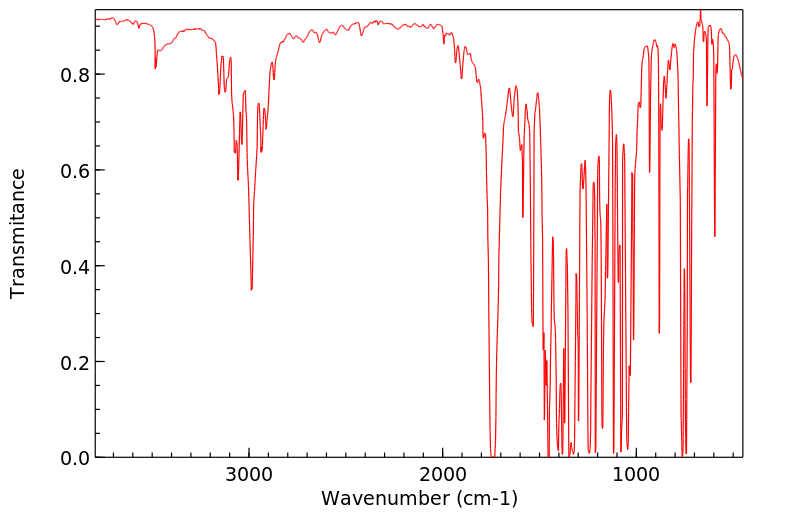1H-吲哚-1-羧酸乙酯 | 13307-67-0
中文名称
1H-吲哚-1-羧酸乙酯
中文别名
——
英文名称
ethyl 1H-indole-1-carboxylate
英文别名
N-ethoxycarbonylindole;N-carboethoxyindole;indole-1-carboxylic acid ethyl ester;N-ethoxycarbonylindol;1-(ethoxycarbonyl)indole;ethyl indole-1-carboxylate
CAS
13307-67-0
化学式
C11H11NO2
mdl
——
分子量
189.214
InChiKey
OEXNQFWEJRSZBW-UHFFFAOYSA-N
BEILSTEIN
——
EINECS
——
-
物化性质
-
计算性质
-
ADMET
-
安全信息
-
SDS
-
制备方法与用途
-
上下游信息
-
文献信息
-
表征谱图
-
同类化合物
-
相关功能分类
-
相关结构分类
计算性质
-
辛醇/水分配系数(LogP):2.7
-
重原子数:14
-
可旋转键数:2
-
环数:2.0
-
sp3杂化的碳原子比例:0.18
-
拓扑面积:31.2
-
氢给体数:0
-
氢受体数:2
安全信息
-
海关编码:2933990090
SDS
反应信息
-
作为反应物:描述:1H-吲哚-1-羧酸乙酯 在 sodium hydroxide 、 transformed Escherichia coli cells 作用下, 以 乙醇 为溶剂, 反应 3.0h, 生成 L-色氨酸参考文献:名称:Berg, E. M. M. van den; Jansen, F. J. H. M.; Goede, A. T. J. W. de, Recueil des Travaux Chimiques des Pays-Bas, 1990, vol. 109, # 4, p. 287 - 297摘要:DOI:
-
作为产物:描述:N-(2-碘苯基)氨基甲酸乙酯 在 bis-triphenylphosphine-palladium(II) chloride 、 copper(l) iodide 、 copper(II) bis(trifluoromethanesulfonate) 、 三乙胺 作用下, 以 1,2-二氯乙烷 为溶剂, 反应 23.0h, 生成 1H-吲哚-1-羧酸乙酯参考文献:名称:Cu(II)盐催化2-乙炔基苯胺衍生物合成吲哚环的有效方法的开发及其在天然产物合成中的应用摘要:研究了Cu(II)盐催化吲哚合成的有效方法的开发及其应用。已经证明,Cu(OAc)2是合成各种1-对甲苯磺酰基或1-甲基磺酰吲哚的最佳催化剂,这些1-对甲苯磺酰基或1-甲基磺酰吲哚在吲哚的芳环和C2位置均具有吸电子和供电子基团。对于初级苯胺衍生物,Cu(OCOCF 3)2表现出良好的活性,而Cu(OAc)2是仲苯胺环化的良好催化剂。该方法可用于在同一分子中具有亲电子部分的化合物的顺序环化反应。通过用KH预先处理,实现了顺序环化以提供三环系统,但第二个环化仅限于五元和六元环。最后,完成了以Cu(II)促进的吲哚合成为关键步骤的马匹的正式和全合成。DOI:10.1021/jo035528b
文献信息
-
Enantioselective Formal [4+2] Cycloadditions to 3-Nitroindoles by Trienamine Catalysis: Synthesis of Chiral Dihydrocarbazoles作者:Yang Li、Fernando Tur、Rune Pagh Nielsen、Hao Jiang、Frank Jensen、Karl Anker JørgensenDOI:10.1002/anie.201509693日期:2016.1.18enantioselective formal [4+2] cycloadditions of 3‐nitroindoles are presented. By using 3‐nitroindoles in combination with an organocatalyst, chiral dihydrocarbazole scaffolds are formed in moderate to good yields (up to 87 %) and enantioselectivities (up to 97 % ee). The reaction was extended to include enantioselective [4+2] cycloadditions of 3‐nitrobenzothiophene. The reaction proceeds through a [4+2] cycl
-
[EN] ALLOSTERIC BINDING COMPOUNDS<br/>[FR] COMPOSÉS DE LIAISON ALLOSTÉRIQUES申请人:UNIV AARHUS公开号:WO2010094289A1公开(公告)日:2010-08-26The present invention relates to allosteric binding compounds of formula (I), especially for the treatment of CNS disorders, together with pharmaceutical compositions and methods of treatment including these compounds.本发明涉及具有公式(I)的变构结合化合物,尤其用于治疗中枢神经系统疾病,以及包含这些化合物的药物组合物和治疗方法。
-
Novel Tricyclic Modulators of Cannabinoid Receptors申请人:Diaz Philippe公开号:US20120039804A1公开(公告)日:2012-02-16The compounds of the invention are modulators of cannabinoid receptors CB1 or CB2. The compounds can be used for the prevention or treatment of, e.g., pain, cancer, skin diseases, weight-associated disorders, chemical addictions, psychiatric disorders, neurodegenerative disorders, bone diseases, and inflammatory diseases. The compounds of the invention can further be used to study these diseases and disorders, as well as cannabinoid receptor biology, by coupling the compounds to, e.g., imaging agents.
-
TFA-promoted direct C–H sulfenylation at the C2 position of non-protected indoles
-
2-(2-Haloalkenyl)-aryl Halides as Substrates for Palladium-Catalysed Tandem CN Bond Formation: Efficient Synthesis of 1-Substituted Indoles作者:Michael C. Willis、Gareth N. Brace、Thomas J. K. Findlay、Ian P. HolmesDOI:10.1002/adsc.200505484日期:2006.52-(2-Haloalkenyl)-aryl halides, conveniently prepared in a single step from the corresponding o-halobenzaldehydes, are combined with amines under Pd catalysis to provide 1-substituted indoles. All combinations of Br and Cl leaving groups can be employed, and a range of substituents on the arene, alkene and amine, can all be tolerated. The use of 1,3-dichloro-substituted arenes allows a third amination
表征谱图
-
氢谱1HNMR
-
质谱MS
-
碳谱13CNMR
-
红外IR
-
拉曼Raman
-
峰位数据
-
峰位匹配
-
表征信息
同类化合物
(Z)-3-[[[2,4-二甲基-3-(乙氧羰基)吡咯-5-基]亚甲基]吲哚-2--2-
(S)-(-)-5'-苄氧基苯基卡维地洛
(R)-(+)-5'-苄氧基卡维地洛
(R)-卡洛芬
(N-(Boc)-2-吲哚基)二甲基硅烷醇钠
(E)-2-氰基-3-(5-(2-辛基-7-(4-(对甲苯基)-1,2,3,3a,4,8b-六氢环戊[b]吲哚-7-基)-2H-苯并[d][1,2,3]三唑-4-基)噻吩-2-基)丙烯酸
(4aS,9bR)-6-溴-2,3,4,4a,5,9b-六氢-1H-吡啶并[4,3-B]吲哚
(3Z)-3-(1H-咪唑-5-基亚甲基)-5-甲氧基-1H-吲哚-2-酮
(3Z)-3-[[[4-(二甲基氨基)苯基]亚甲基]-1H-吲哚-2-酮
(3R)-(-)-3-(1-甲基吲哚-3-基)丁酸甲酯
(3-氯-4,5-二氢-1,2-恶唑-5-基)(1,3-二氧代-1,3-二氢-2H-异吲哚-2-基)乙酸
齐多美辛
鸭脚树叶碱
鸭脚木碱,鸡骨常山碱
鲜麦得新糖
高氯酸1,1’-二(十六烷基)-3,3,3’,3’-四甲基吲哚碳菁
马鲁司特
马鞭草(VERBENAOFFICINALIS)提取物
马来酸阿洛司琼
马来酸替加色罗
顺式-ent-他达拉非
顺式-1,3,4,4a,5,9b-六氢-2H-吡啶并[4,3-b]吲哚-2-甲酸乙酯
顺式-(+-)-3,4-二氢-8-氯-4'-甲基-4-(甲基氨基)-螺(苯并(cd)吲哚-5(1H),2'(5'H)-呋喃)-5'-酮
靛青二磺酸二钾盐
靛藍四磺酸
靛红联二甲酚
靛红磺酸钠
靛红磺酸
靛红乙烯硫代缩酮
靛红-7-甲酸甲酯
靛红-5-磺酸钠
靛红-5-磺酸
靛红-5-硫酸钠盐二水
靛红-5-甲酸甲酯
靛红
靛玉红衍生物E804
靛玉红3'-单肟5-磺酸
靛玉红-3'-单肟
靛玉红
靛噻
青色素3联己酸染料,钾盐
雷马曲班
雷莫司琼杂质13
雷莫司琼杂质12
雷莫司琼杂质
雷替尼卜定
雄甾-1,4-二烯-3,17-二酮
阿霉素的代谢产物盐酸盐
阿贝卡尔
阿西美辛杂质3







